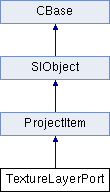#include <xsi_texturelayerport.h>
The TextureLayerPort is an object used to describe which specific shader and material parameters a TextureLayer affects. Like shader connections, they indicate what shader ports are being driven by the layer.
The port has a few properties which describe how the layer affects a single shading parameter, generally these are used to modify the layer's settings in a port-specific way, for example by inverting or scaling the overall effect. A layer may be set up to blend its color by 50% with the layer beneath it. However, that layer's the ambient port effect may only be 25% whereas the diffuse port contribution could be set to 100%.
using namespace XSI;
Application app;
Model root = app.GetActiveSceneRoot();
X3DObject mySphere;
root.AddGeometry( L"Sphere",L"MeshSurface",L"" ,mySphere );
Material myMaterial;
mySphere.AddMaterial(L"Phong",false,L"",myMaterial);
CRefArray myShaders;
Shader myPhong;
myShaders = myMaterial.GetShaders();
myPhong = myShaders[0];
TextureLayer myLayer;
// Add a layer (since there are no others the "After" flag is irrelevant).
myLayer = myPhong.CreateTextureLayer( L"DirtLayer", true );
CRefArray myPorts(3);
// Add some texture layer port connections on this layer.
myPorts[0] = myLayer.AddTextureLayerPort( myPhong.GetParameters().GetItem( L"ambient" ) );
myPorts[1] = myLayer.AddTextureLayerPort( myPhong.GetParameters().GetItem( L"diffuse" ) );
myPorts[2] = myLayer.AddTextureLayerPort( myPhong.GetParameters().GetItem( L"specular" ) );
myPorts = myLayer.GetTextureLayerPorts();
app.LogMessage( L"Created " + CValue(myPorts.GetCount()).GetAsText() + L" ports." );
for ( LONG i = 0; i < myPorts.GetCount(); i++ )
{
TextureLayerPort curPort = myPorts[i];
app.LogMessage( CValue(i + 1L).GetAsText() + L": " + curPort.GetName() +
L" --> " + curPort.GetTarget().GetFullName() );
}
myLayer.RemoveTextureLayerPort( myPorts[1] );
myLayer.RemoveTextureLayerPort( myLayer.GetFullName() + L"." + TextureLayerPort(myPorts[2]).GetName() );
myPorts = myLayer.GetTextureLayerPorts();
app.LogMessage( L"Only " + CValue(myPorts.GetCount()).GetAsText() + L" remain(s) after removal." );
for ( i = 0; i < myPorts.GetCount(); i++ )
{
app.LogMessage( CValue(i + 1L).GetAsText() + L": " + TextureLayerPort(myPorts[i]).GetFullName() );
}
// This example should output something like this:
// INFO : "Created 3 ports."
// INFO : "1: ambient --> sphere.Material.Phong.ambient"
// INFO : "2: diffuse --> sphere.Material.Phong.diffuse"
// INFO : "3: specular --> sphere.Material.Phong.specular"
// INFO : "Only 1 remain(s) after removal."
// INFO : "1: sphere.Material.Phong.DirtLayer.ambient"

Public Member Functions |
|
| TextureLayerPort () | |
| ~TextureLayerPort () | |
| TextureLayerPort (const CRef &in_ref) | |
| TextureLayerPort (const TextureLayerPort &in_obj) | |
| bool | IsA (siClassID in_ClassID) const |
| siClassID | GetClassID () const |
| TextureLayerPort & | operator= (const TextureLayerPort &in_obj) |
| TextureLayerPort & | operator= (const CRef &in_ref) |
| Parameter | GetTarget () const |
| TextureLayerPort | ( | ) |
Default constructor.
| ~TextureLayerPort | ( | ) |
Default destructor.
| TextureLayerPort | ( | const CRef & | in_ref | ) |
Constructor.
| in_ref | constant reference object. |
| TextureLayerPort | ( | const TextureLayerPort & | in_obj | ) |
Copy constructor.
| in_obj | constant class object. |
| bool IsA | ( | siClassID | in_ClassID | ) | const [virtual] |
Returns true if a given class type is compatible with this API class.
| in_ClassID | class type. |
Reimplemented from ProjectItem.
| siClassID GetClassID | ( | ) | const [virtual] |
| TextureLayerPort& operator= | ( | const TextureLayerPort & | in_obj | ) |
Creates an object from another object. The newly created object is set to empty if the input object is not compatible.
| in_obj | constant class object. |
| TextureLayerPort& operator= | ( | const CRef & | in_ref | ) |
Creates an object from a reference object. The newly created object is set to empty if the input reference object is not compatible.
| in_ref | constant class object. |
Reimplemented from ProjectItem.
| Parameter GetTarget | ( | ) | const |